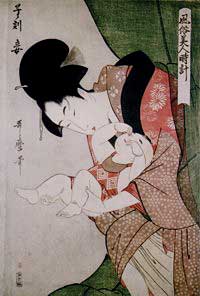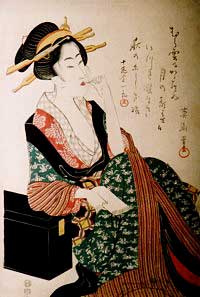 |
 |
 |
| Kitagawa Utamaro, "Clock of Beauties with Customs and Manners: Hour of the Rat (12 a.m.), the Mistress" |
 |
Ukiyoe have been the object of Western ardor ever since the post-impressionists fell in love with them over a century ago. I am no exception to this weakness, and I can happily testify that Tokyo is hog-heaven for an ukiyoe addict. Besides the permanent collections in all the major art museums, on any given day you can count on finding at least a couple of ukiyoe shows at galleries around town. Whether your taste runs to portraits of courtesans and kabuki actors, or to the ubiquitous "scenes" series of mountains, highways, and Edo-era cityscapes, you will never want for an ukiyoe fix in this town.
Surprisingly, though, there are hardly any museums in Tokyo -- indeed, no more than a handful around the country -- devoted solely to the genre. One that stands out is the Ota Memorial Museum of Art, tucked incongruously down a back alley just behind LaForet in Harajuku, belly of the Tokyo fashion beast.
Open since 1980 in a modest two-story building designed for the purpose, the Ota was built for ukiyoe-viewing. At the entrance you switch from shoes to slippers, then remove those to step onto tatami mats arranged for close scrutiny of the scrolls along one wall. Subdued lighting is employed to minimize damage to the collection, display of which rotates monthly. The museum is privately owned by the Ota family, heirs to patriarch Ota Seizo V (1893-1977), a life insurance company executive who amassed some 12,000 pieces. Given that a large proportion of the museum's visitors are foreigners, it is ironic, as well as fortuitous, that Ota was motivated by his fear that the massive outflow of ukiyoe to the West at the turn of the century would deprive Japanese of the chance to view the originals at home.
This vast collection spans the entire golden age of woodblock art, from the Edo era into the Meiji. It covers not only the big names familiar to Westerners -- Hokusai, Hiroshige, Utamaro (though Ota's tastes evidently did not extend to the Meiji-era grotesqueries of Yoshitoshi) -- but a host of lesser-known yet equally exquisite artists. In October this year, a visitor was treated to a galleryful of bijinga -- "pictures of beautiful women" -- by the pioneer and acknowledged master of the genre, Utamaro, as well as his contemporary Eishi, good enough to merit a reputation as Utamaro's rival at the time. November continues the bijinga theme with works by Eizan and Eisen, representatives of the next generation who flourished at the very end of the Edo era.
 |
 |
 |
 |
 |
left: Keisai Eisen, "First Snow"
right: Kikukawa Eizan, "Geisha Leaning on Her Shamisen Box" |
|